Shungnak is a small Inupiaq village that lies about 150 air miles up the Kobuk River from Kotzebue. In 1958 it had a population of about 150. Oliver learned from a traveling nurse that there were no empty houses in the village, but this did not deter him. He believed that he and his family were meant to move there, so he continued making plans.
First, though, he needed a boat. One day his lumber-cutting partner, Charlie Jones, came by and offered to exchange the boat he had built from his share of their lumber for Oliver’s small house on skids. The boat was 30 feet long and had a cabin, about right for the trip. Oliver put a sliding door on the cabin to retain the heat from their cook stove.
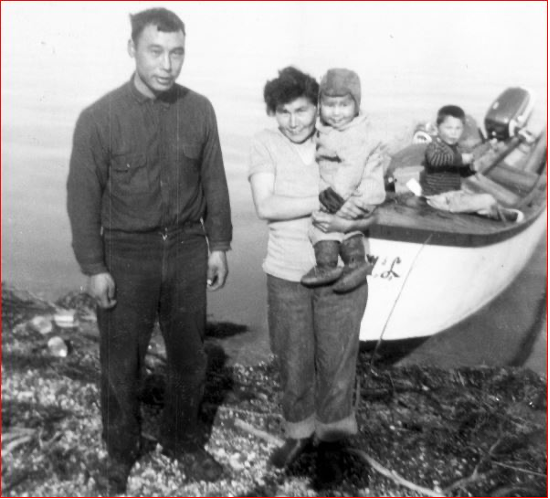
Photo from the Cameron Family Collection.
While it might be 150 air miles from Kotzebue to Shungnak, the distance by water is much longer. The first stretch is across the wide expanse of Hotham Inlet (known locally as Kobuk Lake) to one of the channels of the Kobuk River, where the depth ranges up to 90 feet. The river then meanders for another 225 miles as it passes through the villages of Noorvik, Kiana and Ambler. With each mile the water becomes progressively shallower, the bottom rockier and less forgiving. In a low water year, an inexperienced boatman should carry an extra propeller, or travel with a guide.
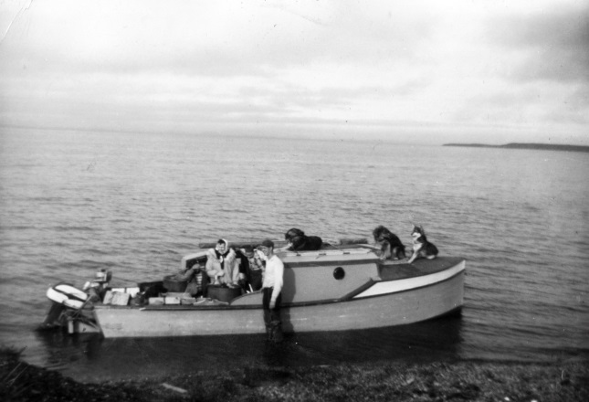
Things began to come together when Oliver discovered that Gordon Mitchell, a Friends Church pastor, also wanted to make the trip. The two joined forces, and by early September the pastor had acquired a similar boat.
First they had to wait while the wind died down on the inlet. Oliver slept in the boat in the lagoon behind Kotzebue, while Rene looked after the children on land, staying in a friend’s house. On September 12th it finally became calm and they were able to launch out onto the inlet, now as smooth as glass. There was a welcome absence of mosquitoes out on the lake, and a view of the Noatak Mountains in the distance. As they were leaving Hotham Inlet, Charlie Jones gave them caribou meat. Later, when they briefly stopped by Pipespit just outside of Kotzebue and saw Lena Satterlee, she gave those roasted ducks and turnips for their first meal.
They had been joined by Louie Commack and his boat, and the three traveled single file, tied together by a long rope, the Cameron boat in the middle. They camped overnight at a friend’s tent site near the mouth of the Kobuk River.
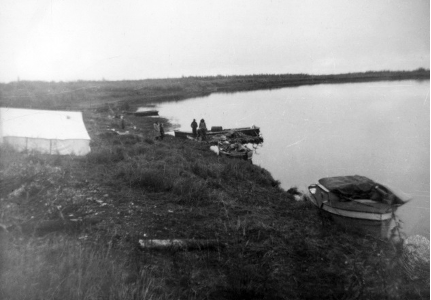
Photo from the Cameron Family Collection.
The next morning, as they started up river, they had to break through ice and go single file. Louie’s boat turned off at a fork in the river, and Oliver and Gordon proceeded to Noorvik. After having lunch with friends, Oliver and Gordon continued on to Kiana in their boats. They stopped there for a couple of nights, attending church and visiting with friends. They also took on supplies, extra gas, and gifts of food from local people—cranberries, dried fish, caribou meat, and oranges.
The stretch of river from Kiana to Shungnak was uninhabited except for scattered fish camps and the brand new village of Ambler. Scraggly black spruce gave way to occasional patches of straight, white spruce that dotted the tundra landscape and grew taller with each mile. The Jade Mountains stood out as a beckoning landmark on the left, and the more subdued Waring Mountains slowly rose on the right.
The trip was leisurely, the current about three miles per hour, and they often spent time eating and visiting with their traveling companions. The weather remained cool but pleasant. Dressed warmly, the Camerons enjoyed the changing scenery, the clear skies, and the fall colors.
When they camped along the river, Oliver staked his dogs on shore. The children slept inside the boat cabin, while Oliver and Rene slept on the top of the cabin or on the boat deck in sleeping bags that zipped together.
Sometime after they left Kiana a boat that was coming downriver crossed in front of them and then headed for the beach. This was the river signal for ‘stop and talk.’ It turned out that the Shungnak Friends Church had sent the boat’s pilot, Homer Cleveland, to guide them the rest of the way up the river. The travelers were pleased with this thoughtful, welcoming gesture.
They all camped out that night, and from then on Homer hitched his boat to theirs and towed it in order to make better time against the current. It began to rain, so they all donned more clothing. They reached the new village of Ambler by dark, and stopped for the night. They had been on the water for five days, and were125 miles out from Kotzebue.
The first five families had moved to the brand new settlement of Ambler just a few short weeks before Oliver and Rene began their trip. They were working on their cabins in the daytime, and passing the nights in tents on the opposite side of the river. They invited the party to join them for dinner.
At some point in the evening the villagers suggested, in their humble and indirect way, that the travelers were welcome to spend the night in their tents. Unfortunately, Oliver and Rene misunderstood their lack of a specific invitation, and as a result spent a cold, damp night on the top of the boat cabin. They later learned they could have been warm and dry if they had only indicated which tent they wished to use.
Leaving the fledgling Ambler village in the morning, the caravan next stopped at Homer’s fish camp at Black River, where he had left his family. After drying their damp clothing and enjoying a meal of duck soup and blueberries, the travelers were back on the river. In late afternoon they caught a glimpse of a schoolhouse on a hill—their first view of Shungnak.
In spite of being told there were no empty houses in Shungnak, Oliver had arranged to rent a cabin. Their new landlord, local resident Tommy Lee, had built a fire and warmed it up. The weary family moved right in.
The 14 x 16 foot cabin was perched on the bank of the river, downhill from the schoolhouse. It had two windows that overlooked the river. The cabin was furnished with a table and some wooden Blazo boxes that served as nightstands and bookshelves. A large cook stove with an oven sat in the middle of the room, and Oliver and Rene’s bed was to one side. The two older children slept in sleeping bags on caribou skins on the floor; Gerald slept in a box that Oliver built for him.
Oliver later built closets with curtains at the foot of the bed. The house was cold at first, but Oliver put logs and dirt around the base of the house to keep the cold air from coming up through the flooring. That made the cabin warmer.
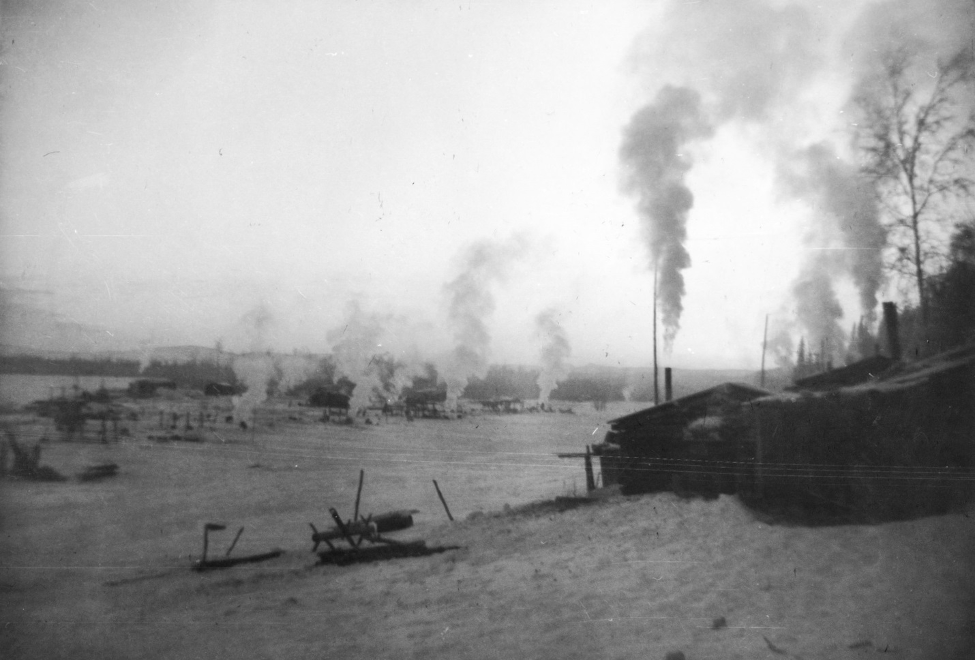
By this time Richard was in fifth grade and Dorene was in fourth. They followed a trail up the hill to the school, and when it began snowing in October, they could slide swiftly back down, right into their own front yard.
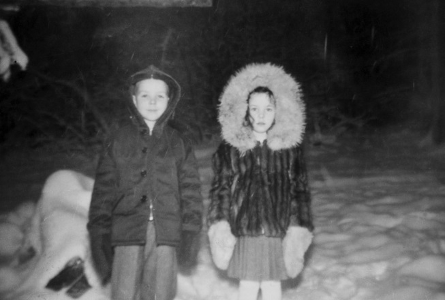
Rene repurposed a fur coat to make the parka for Dorene.
Photo from the Cameron Family Collection.
Shortly after their arrival in Shungnak, the pilot of the mail plane pilot alerted the village to the location of a herd of caribou. A group of local men invited Oliver to go hunting with them. They traveled by dog team about four miles beyond the village, and then staked down their dogs to keep them from chasing the caribou.
Some of the men went behind the caribou and drove them past the others, who shot as many as they could. After gutting the animals, the men broke for a lunch of dried fish and tea. Then they divided the carcasses among themselves and sorted their shares into piles. Each of the eight men got four-and-a-half caribou.
Oliver brought one home that night, to the family’s delight, and spent another day or so processing and hauling home the rest of his share. Now they had meat for the winter. They saved the blood and innards for the dogs, giving them a change from the fish and cornmeal that Rene usually fed them.
The family quickly settled into household routines. Oliver hunted and maintained the cabin. Every few days he took his dog team to the wood-cutting area, about eight miles away, and brought back loads of firewood. He used his chain saw to cut down white spruce, birch, and sometimes alder. Once he had the logs home, he’d cut them to stove length with a bow saw.
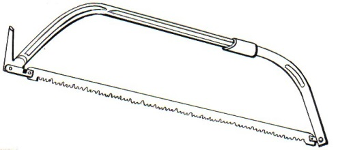
Image: Public Domain. http://commons.wikimedia.org/wiki/File:Bow_Saw_ (PSF).jpg
Pipes from the river led through the Camerons’ yard up the hill to the school and teachers’ quarters. Every few weeks the school custodian would pump river water up to the school. Early that winter the pipes froze and burst, flooding the Cameron’s yard with water and forming a sheet of ice. Fortunately the house was untouched, and sawdust from Oliver’s firewood cutting soon covered the ice and eliminated the slipping hazard.
Rene did the cooking and kept the house in order. She also packed in a supply of water from the river every three days. On laundry days she would haul the water the night before, so that it would begin heating as soon as Oliver started the fire the next morning. Once breakfast was over and the children were off to school, she would agitate the clothes in a tub with a “stomper” (a vintage laundry tool), scrub them on a washboard, rinse them, and hang them to dry around the cabin and over the stove.
After a few weeks, the teacher invited her to come up on Saturdays to share her electric washer. Rene hung her laundry to dry there, too, and went back up the hill on Sunday to collect her dry clothing. This also gave her some social time with her neighbors, and ended the physical drudgery as well as the nuisance of damp clothes hung all over her small cabin.
One time Rene accepted an invitation to play a bowling game at the school. She had fun, but it seemed a frivolous activity to her in view of all the work that needed to be done, and she never went again. But as was her habit, she was active in the local Friends Church, teaching Sunday school, playing the organ, and singing for services.
Rene once used her toothache kit to ease the pain of a local grandmother with a bad tooth, until the woman could get to the dentist in Kotzebue. In typical Inupaiq fashion, the woman later gave Rene a pair of fur mittens made from a wolf head.
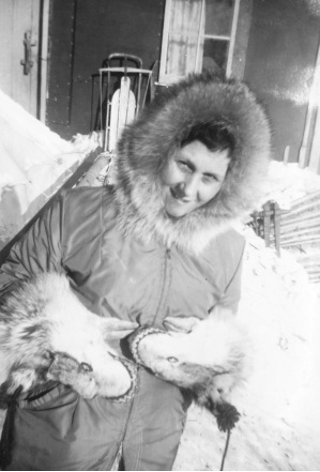
Photo from the Cameron Family Collection.
The Cameron house, with games, toys and playmates, was again a magnet for local children. Rene was pleased that her kids had a lot of visitors. She preferred to have them home, where she could monitor language and behavior and not be worried about where they were. Nevertheless, despite her best efforts, they had their share of adventures.
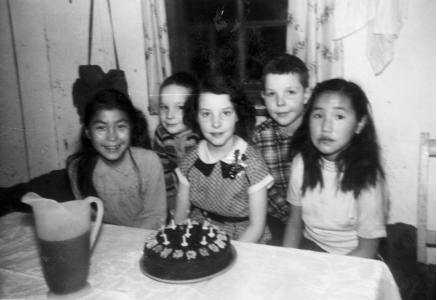
Dorene’s birthday party, February 1959, Shungnak.
Photo from the Cameron Family Collection.
One time Richard was invited to go fishing for an evening by one of Oliver and Rene’s friends. He was a reliable man in his forties who had lived there all his life, so they felt safe in granting permission. Richard grabbed a wash basin for his expected catch.
When he had not returned by midnight, Rene woke Oliver. He didn’t share her alarm, and advised her to be patient. Rene paced for a time inside the cabin, then in the front yard. Eventually she returned to bed, but was still awake at 5 a.m. when she heard the sound of a motor and ran out to meet the errant fishermen.
The friend, sensing Rene’s anxiety, recounted their leisurely and uneventful trip, which included an early morning breakfast with his sister. Richard was grinning ear to ear, and his basin was full of fish—he’d caught 26 grayling.
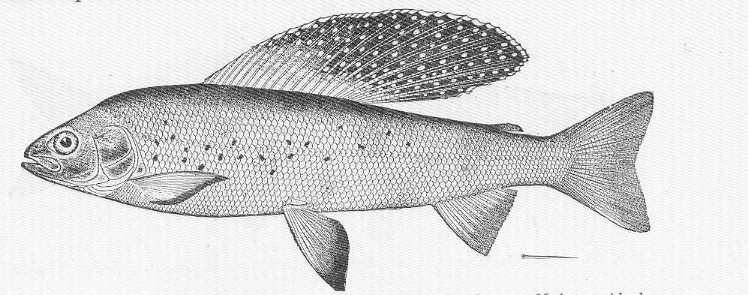
Shungnak received mail by air once a week. The mail plane landed on a gravel bar in the summer, and on the river ice in winter. For three weeks during December there were no mail deliveries at all, due to low visibility. Finally a pilot who was familiar with the terrain came in, bringing Christmas packages and orders. However, to everyone’s great disappointment, the airline had forgotten to put the first class mail aboard.
The villagers in Shungnak celebrated Christmas as thoroughly as did the folks in Kotzebue, and people from the upstream village of Kobuk traveled thirty miles by dogsled to join the festivities, which centered on the school and the church. Santa made an appearance at the children’s school program, and friends, the teacher, and the Red Cross provided a variety of gifts for children and adults.
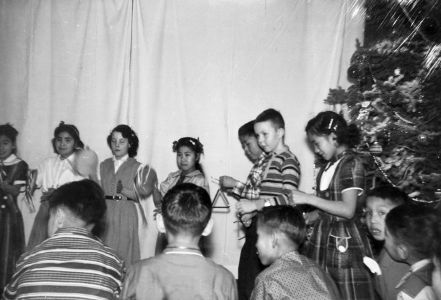
The church had its own program the following night, Christmas Eve, with another play and more gifts. The Camerons continued the celebration after returning home, opening gifts around a small tree that stood on a box by the stove. They returned to church the next day for a feast of caribou soup, bread, berries, and greens followed by “Eskimo” ice cream, Jell-O, crackers and candy. There were additional services at the church every night that week, culminating in a two-hour service to see in the New Year.
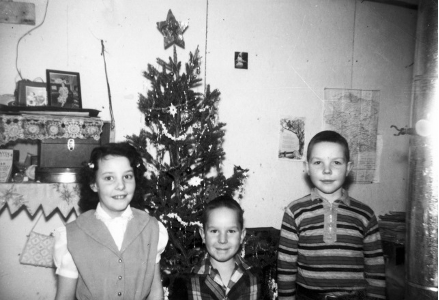
Photo from the Cameron Family Collection.
In the spring of 1959, as the ice began to break up and move out, Shungnak went on flood watch. There was always a chance that backups caused by ice jams would flood the houses nearest the river, but fortunately the Camerons escaped that calamity. By that time, however, the strain of the cold, hard work, and lack of income had begun to take a toll on both Oliver and Rene.
Rene had been having a troublesome pain in her left breast. Around April, Oliver began to have digestive problems and to pass blood. Since he was not able to eat regular food, Rene made bowls of Jell-O and put them out in the ice that still covered their yard, so that they would set.
Oliver and Rene endured that way until concerned relatives sent funds for them to return to Kotzebue to see the doctor. It took them a week to get everything in order and say goodbye to their friends. Everything took longer because of their health issues—doing laundry, packing, cleaning house, mixing gas, organizing the boat, loading the dogs. Friends helped, and eventually they got started on a summer afternoon, a bit later than planned.
Since they were still too inexperienced to navigate the difficult Kobuk River by themselves, Arthur Douglas, a relative of Tommy Douglas, the founder of Ambler, agreed to guide them as far as Ambler. Some friends in Fairbanks, though of course unaware of their emergency trip, had providentially sent a food box containing numerous items that made their travels easier: bacon, cake mixes, canned vegetables, canned meats, soups, dried fruit and candy.
Around 11:30 that evening, under perpetual daylight, Arthur guided them to the beach at Ambler and set up beds for them in Tommy Douglas’s house. Here they spent the weekend while locals helped Oliver do some remodeling on the boat. Richard came down with diarrhea, an uncomfortable and unwelcome complication.
Once they had finished the repairs, they continued downriver. Since they were now on their own, it was a challenge to stay in safe water. Oliver studied the surface of the water, trying to discern the channel, but missed it more than once. Finally, they found themselves stuck with the boat completely grounded.
Oliver got out of the boat to search for the channel. Rene attempted to wade with him, but didn’t have hip boots and had to give it up. Finally, Oliver levered the overloaded boat into water deep enough that he could lower the motor and continue downriver, proceeding slowly.
When they reached Kiana, about two-thirds of the way to Kotzebue, they were greeted warmly by friends. Not knowing that another family had started cooking for them the moment their boat was spotted on the river, they accepted a dinner invitation from their first greeters, and were a bit embarrassed when they got the second invitation. Likewise they were offered warm beds in several homes.
Here, too, someone gave Rene the solution to Richard’s intestinal problems: a teaspoon of pepper. That stopped the diarrhea. Oliver used this remedy for years afterward, making the dose more palatable by coating the pepper in jam before swallowing it.
The villagers gave them gifts of soap, mittens, warm bread and cash for the children before they got underway again. Now that they were in reliably deep water, the rest of the trip was uneventful. They set up their tent on the beach at Kotzebue near the location of their former house, which Charlie Jones had taken in trade for the boat and since moved.
They reunited with old friends and met a new couple, Donna and Wilfred Zibell. Wilfred had been sent by the Wycliffe Institute with the goal of translating the Bible into the Inuit language. Oliver had spent some of his spare time in Shungnak paraphrasing the Gospel of Mark for the local people, so the two had common interests. They spent many hours visiting.
They also visited the clinic, but Oliver continued to bleed and the doctor could not find the source of Rene’s pain. They decided to return to Idaho for further medical care.
They flew to Fairbanks in the fall of 1959. The children, who had spent several years living in Kotzebue and the small villages along the Kobuk River, found the city unsettling. They experienced a degree of culture shock as they dealt with the bustle of the busy airport and the unfamiliar sensation of traveling in a car.
When they arrived in Nampa, Idaho, they found that their friends from Fairbanks, Dr. and Mrs. Fitz, were leaving Idaho for a few months. The Fitzes gave the Camerons the use of their house on Chestnut Street, where they stayed for the winter. Richard enrolled in sixth grade; Dorene, in fifth. The school was only two or three blocks away. Dorene recalls that the classroom was crowded, and that she had to share a desk with another student.
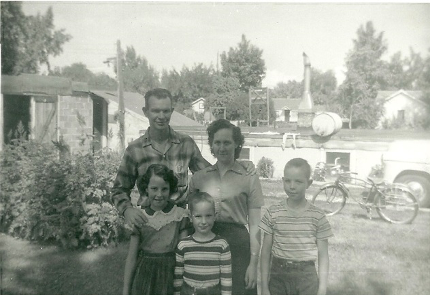
Photo from the Cameron Family Collection.
When the holiday season rolled round, Oliver—reacting to the materialism and excess he perceived around him—decided it was frivolous and irresponsible to buy a Christmas tree while others were in need. He headed downtown to donate the $10 price of tree to the Salvation Army, but while he was away someone gave a tree to his family, along with a pile of gifts and food. The timing of these benevolences made a lasting impression on the children.
Oliver remained unemployed that winter while both he and Rene were recovering. With proper treatment and rest, Oliver’s stomach improved. He moved the family north to New Meadows, where they stayed with his parents, Ed and Pansy, for the 1960-61 school year. Rene enjoyed being near family in the relatively stress-free environment of New Meadows, and regained her health. She took substitute-teaching jobs and also worked in the local post office.
Oliver himself went back to Shungnak, where he stayed with Bob Lee, who had been a good friend there previously. Sometime during that winter he unwittingly damaged his lungs while retrieving some caribou carcasses with his dog team. He had cached the caribou meat on high ground in the low mountains north of Shungnak. He went alone, following a trail made by the Inuit. It was getting late by the time he reached his cache, so instead of going back down the slow, gentle slope he had climbed, he tied the meat to his sled and went down the steep face of the hill. This put him traveling rugged terrain for some distance and Oliver was overheated by the time he got to the river, not realizing it was -65°. He had pushed the hood of his parka back for ventilation and by the time he got home he had frosted his trachea. The effects of that mishap would plague him for the rest of his life, causing breathing problems in cold weather.
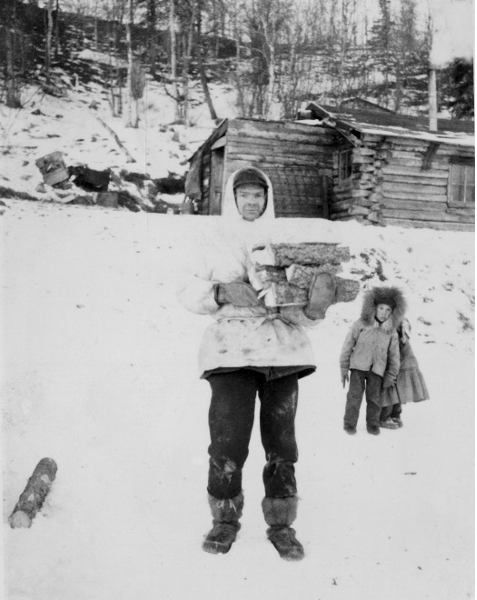
Photo from the Cameron Family Collection.
When Ed Cameron’s health began to fail in the spring of 1961, Oliver returned to Idaho. He helped with his father’s school maintenance job in New Meadows, and later moved to the town of Old Meadows to care for the school there as well. When the elder Camerons moved to Payette, Idaho, Oliver and his family rented their home in New Meadows for 1962-63.
Oliver continued to split his time between Idaho and Alaska. At one point during these years he stayed in Fairbanks, where he helped a friend build and sell dogsleds. He also returned to Shungnak, learning more about sled-building, hunting, and skills for living off the land. Finally, he began contracting construction jobs during the summer in Kotzebue in order to earn enough money to bring Rene and the children home. Searching for a homesite for his family, Oliver was drawn to the still-new village of Ambler. He was able to claim a five-acre parcel just outside the village, and spent the winter of 1962-63 cutting logs for the house he planned to build. By the summer of 1963 it was time to reunite the family.